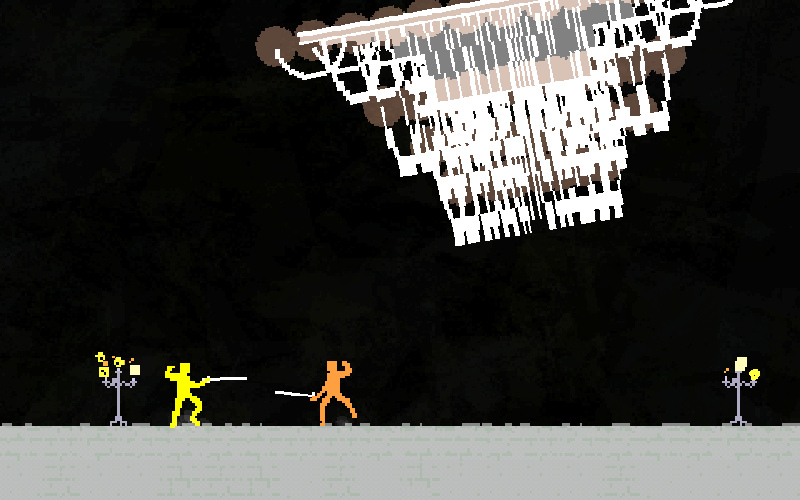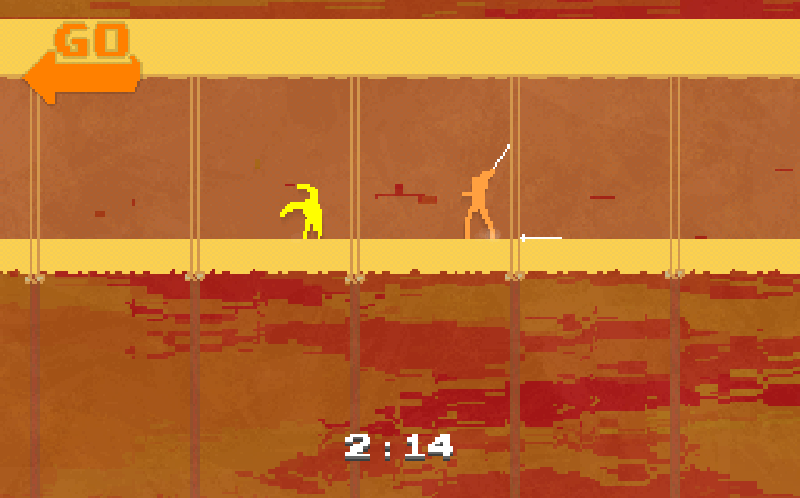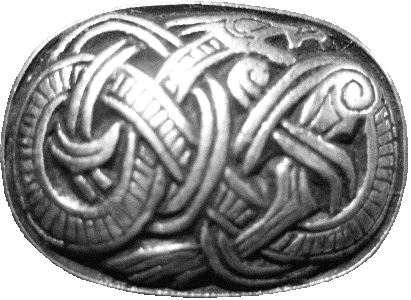Nidhogg is a game I would not usually purchase at first sight: it looks unfinished, undone. Its sprites sway loosely, and brightly colored 'blood' splatters seem jagged and incongruous. The music stacks on top of itself in frenetic, chaotic ways; there is no story to explain, and somehow, there is only one mode of play in the end, really.
And yet... yet, it is perfect. I have nearly killed my friends by introducing them to this game, and then watched them fall off the couch in fits of laughter and glee. Friends picking up controllers, eager to take on the victor of the last match, and often too busy making snarky comments to play at their best. Their spritely avatars fall and die in horrific ways, only to return, hungry for revenge.

It helps that the castle stage reminds me of Hamlet for some reason.
Nidhogg is perfection in one of the weird ways that only small production games can produce, and something that must be experienced to truly understand.Despite my earlier statement, I will, at least, attempt to explain this game: it is a tug of war where the winner is decided on how well you fence, you throw swords, and how fast you can run.
...That's it.
"But Wyatt," you might begin. "How does that even make any sense?"
"I don't know," I would respond. "But you should really play this game!"
Its a contest that starts quickly, and can end brutally fast if you do not know what you are doing. There are four stages, and once one is picked, you are both dropped into the center room, the music (which is fantastic, thanks to Daedelus) kicks in, and you are already able to move, attack, jump...accidentally throw your saber (which I did many times my first few games), and even punch at your opponent if you have lost your blade for whatever reason. You cannot leave this sparse landscape until one of you dies.
Yet, this is where the game begins in earnest: a small little icon showing the winner has gotten the Go appears, and the victor of this initial duel is off, racing, leaping and charging forward. There are five screens in all for each level, and at the far end of one is your victory. Get to the end of the final screen that your opponent defends, and the match is yours.
Ah, yes, you have killed your opponent already, that is true! However, it seems as if you are in a sort of purgatory. There is only a few seconds, perhaps just one, before your opponent reappears, the stain of their former self still seeping into the pixelated floor. He leaps at you, and with a lucky swing, his saber finds your head, or neck, and you find yourself bleeding away as he now runs past, trying to get to his own victory, perchance taking the game back to the next screen....you now one step further away.

You will gladly die, repeatedly, to get that little arrow in your color.
You can see how this game gets frenetic quickly. Beautifully, irrationally chaotic.
For me, Nidhogg is a must buy, and I wish I would have found it sooner: I love games I can play in the same room as my friends, and its awesome to see so many are now returning, like Knight Squad. For many people that love fine tuned fighting games, this will also most likely be a must buy as well. While I enjoy it for it being chaotic and oftentimes hilarious, its also incredibly well tuned, with there to be a counter to almost all attacks. You can throw your blade at people, sure, but its easy enough to dodge with enough preparation, or to knock it out of the air with your own poised saber. You don't have a weapon? You can still dive, roll, and leap to pick up the fallen blades of the poor dead about you... or just trip your opponent and beat him into the ground.
There is only one true 'mode' in the game, with a few variants. Four stages, each with enough differences aesthetically and logistically to make the game feel diverse; if you are playing in the clouds, for example, its good to be light of foot, and more often attempt to outrun your opponents than get mired down in sparring. If you play in the dark mines though, oftentimes there is nowhere to jump and get out of the way: it is time to bring your weapon to bear for bloodshed. Yet, it is enough. This game was made for people to crowd around and take their turns running the gauntlet; in fact, the developers put in a multiplayer mode, making it very easy to set up a tournament for any set amount of players.
One last note about this minimalistic masterpiece: the name. It may seem familiar to you, especially if you have played enough fantasy video games... its for good reason. A serpent of norse mythology, a beast that always is gnawing on the roots of the world tree - where does this come in? Níðhöggr seems a little out of place in a world that seems designed simply around duels to the death with fancy fencing blades.

What does it mean? Why are you eaten by a giant serpent as your victory once you get past the constant respawns of your fencing opponent? It might, just might, have something to do with how "Nid" roughly translates to villain...perhaps two nefarious evil doers, fighting for a chance to escape purgatory? Two heroes in Valhalla, dueling for a chance to fight the great serpent? Maybe it just means nothing, the game developers simply wanting a catchy name with some ambiguity to think about as you stab people, repeatedly...or maybe they just wanted you to get eaten by a giant pink wurm.
Its as I said: a rough, seemingly unpolished game that underneath has thought, technicality, and a whole lot of fun just underneath the surface.